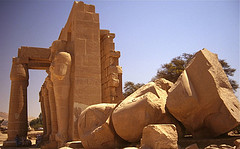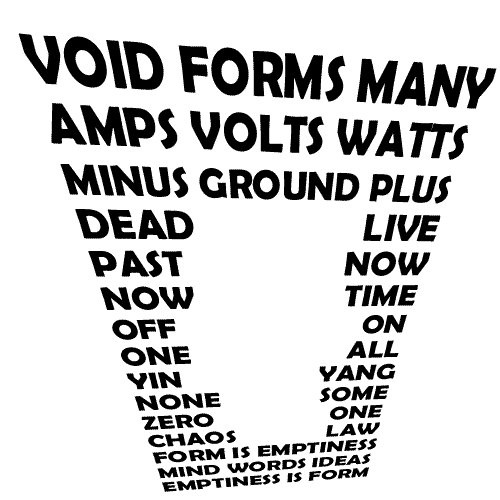Category — Text
Final project: Literacy and Critical Thinking
Here is the abstract of my final paper and a link to both a podcast and a print version.
Abstract:
The New London Group (1996) starts their discussion of multi-literacy by presenting the needs of future citizens in the work place of tomorrow. They argue that to engage and negotiate critically with a working environment, students need to have multi-literacy skills or the ability to communicate meaning through a variety of mediums. Students also need to participate in literacy activities as members of communities; they need to be able to discern meaning from multiple media sources and produce meaning using these “new media.” The change in participation and literacy is in part because hypertext, the Internet, and associated applications have changed the way knowledge is created and presented.
The author is no longer the authority. As we all become authors of a collective knowledge the authority of knowledge is no longer clear, print is no longer associated with truth as it may once have been. Knowledge is created changed and rework, represented mixed and fed in to what is becoming known as a participatory media culture. The following is both a historical and modern understanding of how western society has understood the transmission of knowledge and how the transformation of the transmission has changed what it means to be educated or knowledgeable.
November 30, 2009 No Comments
Language as Cultural Identity
Language as Cultural Identity
Russification of the Central Asian Languages
Pier Borbone asserts that “there is no obligatory relationship between language and writing: per se, every language can be represented with any graphic system, even systems originally created for other languages – if necessary with certain adaptations.” (Borbone, 2007) He further theorizes that “the decision to adopt a certain kind of script depends to a large degree on other considerations, not having to do with the language itself, and that the choices of script made by different peoples and nations are an interesting clue to cultural, political and religious aspects of their history.” (Borbone, 2007)
The former Soviet Union provides an interesting case study when looking at cultural and political implications of using an already existent script for historically and culturally rich but very different languages which already had been using a different script. Specifically looking at the adoption of the Cyrillic alphabet to the Central Asian and Far Eastern languages, we can examine the Russification of these particular languages and cultures.
With the creation of the new Soviet Union came many challenges. One of the major challenges was to create an identity and somehow unify over 100 different ethnic groups. A systematic policy of Russification was adopted by the early Soviet government but it was by no means a new development. Russification dates back to the 16th century with the conquest of Khanate of Kazan and other Tatar areas. At its early stages, Russification mostly involved Christianization and implementation of the Russian language as the sole administrative language.
The Cyrillic alphabet was created by St. Cyril and his brother St. Methodius, who were Byzantine missionaries and were sent to convert the Slavs to Christianity. The original alphabet was known as Glagolitic from which modern day Cyrillic evolved.
Glagolitic alphabet
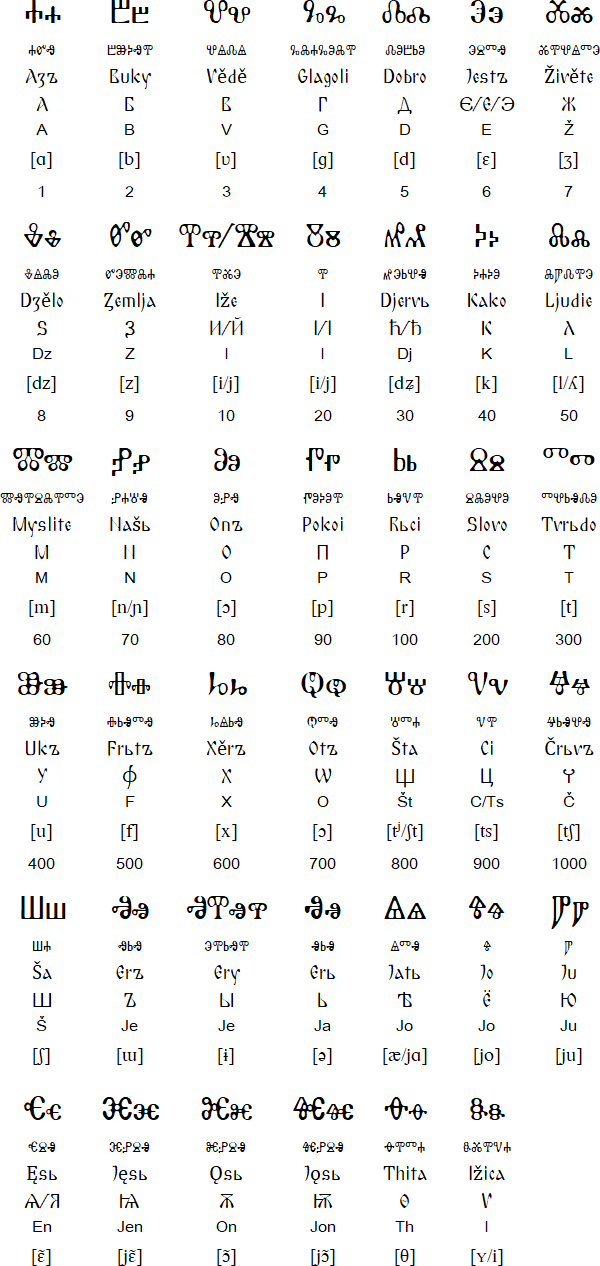
Cursive version of the Glagolitic alphabet

http://www.omniglot.com/writing/glagolitic.htm
1918 version
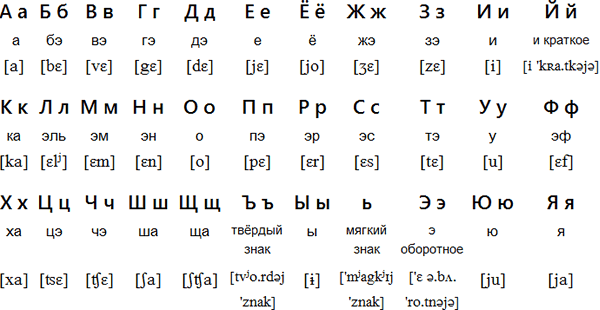
The names of the letters are in Russian.
http://www.omniglot.com/writing/cyrillic.htm
Languages written with the Cyrillic alphabet
Abaza, Abkhaz, Adyghe, Archi, Avar, Azeri, Balkar, Bashkir, Belarusian, Bulgarian, Buryat, Chechen, Chukchi, Church Slavonic, Chuvash, Dargwa, Dungan, Erzya, Even, Evenki, Gagauz, Ingush, Kabardian, Kalmyk, Karakalpak, Kazakh, Komi, Koryak, Kumyk, Kurdish, Kyrghyz, Laz, Lak, Lezgi, Lingua Franca Nova, Macedonian, Mansi, Mari, Moksha, Moldovan, Mongolian, Nanai, Nenets, Nivkh, Old Church Slavonic, Ossetian, Russian, Ruthenian, Serbian, Slovio, Tabassaran, Tajik, Tatar, Turkmen, Tuvan, Tsez, Udmurt, Ukrainian, Uyghur, Uzbek, Votic, Yakut, Yukaghir, Yupik
http://www.omniglot.com/writing/cyrillic.htm
In the early centuries, the Christian missionaries had difficulties in converting eastern Slavs to Christianity due to language barriers. The western missionaries were using Latin and the eastern missionaries were using Greek but both were foreign to the Slavs. St. Cyril (827-869 AD) developed the Glagolitic/Cyrillic script which made the conversion process much simpler. The brothers modeled Glagolitic alphabet on a cursive form of Greek. The Glagolitic alphabet evolved into Old Church Slavonic which “was used as the liturgical language of the Russian Orthodox Church between the 9th and the 12the centuries.” (Blech, 2008) Currently the Russian Orthodox Church uses Church Slavonic which appeared during the 14th century. There are some speculations that the Old Church Slavonic may have been invented by St. Kliment of Ohrid based on the Glagolitic alphabet.
The current form of the Cyrillic alphabet came into being in 1708 during Peter the Great’s westernization and secularization campaigns. The newly modified alphabet was known as grazhdanka.
The 1917 Russian revolution paved the way for the inception of the Soviet Union in 1922 which united several republics under one umbrella. After 1922, the authorities decided to eradicate the use of the Arabic alphabet in Turkic and Persian languages in the Soviet-controlled Central Asia, in the Volga region, including Tatarstan, and in the Caucasus.
This drastic change was well thought out because it detached the local population from the exposure to the language and writing system of the Koran. This served a twofold purpose of curbing religious activities and further separating the local population from their ethnically closer groups in other Middle Eastern countries. As well it prevented the “formation of alternative ethnically based political movements, including pan-Islamism and pan-Turkism.” (Absoluteastronomy, 2009)
A very effective way of accomplishing this was to “promote what some regard as artificial distinctions between ethnic groups and languages rather than promoting amalgamation of these groups and a common set of languages based on Turkish or another regional language.” (Absoluteastronomy, 2009)
The new alphabet was inspired by the Turkish alphabet and was based on the Latin alphabet. However, in 1939-1940, the policy changed and it was decided to change Tatar, Kazakh, Uzbek, Turkmen, Tajik, Kyrgyz, Azeri and Bashkir languages and make them use variations of the Cyrillic alphabet. It was claimed that the switch was made “by the demands of the working class.” (Absoluteastronomy, 2009)
In the Soviet Union the Latin alphabet was first officially introduced in Soviet Azerbaijan in 1925 13, and a “Unified Turkic Latin Alphabet” for all the Turkic languages of Soviet Central Asia followed between 1927 and 1930. In the second half of the 1930s the policy was changed, and a campaign began to introduce, in place of the unified Latin alphabet, several Cyrillic alphabets somewhat different for each Turkic language. For instance, the Cyrillic alphabet for the Uighur language consisted of 41 letters – the Latin one being of 32. (Winner, 1952)
Since the Soviet government decided that a nation was defined by the existence of a language, a language had to be selected each time it was decided that there was to be a nation. This activity produced considerable problems. One of the major ones was the fact that dialectic differences had to be accentuated between the populations of a single linguistic area. Each nation was constructed on the basis of difference.
The most ludicrous case was the separation created between Tajik and Persian. The Tajik used literary Persian as their written language. There exists a perfect comprehensibility between the literary languages current in Iran, Afghanistan and Tajikistan. However, in their daily lives the Persian speakers of Central Asia use dialects which vary considerably. The relationship between Iranian and Tajik Persian is similar to the relationship between Persian French and Quebecois. Russian linguists had to formalize and fix differences and to invent a modern literary Tajik language. Instead of taking one of the existing Tajik dialects as their standard, they created an artificial language which combined characteristics from different regions. They kept the phonological system of Old Persian, but adopted grammatical variations which highlighted the difference with Iran.
Uzbek was also severely manipulated. It was linked with Kazakh and Tatar which have the least similarities with Uzbek. Azerbaijan, Turkmenistan and Uzbekistan were quick to adopt Latin script, Kazakhstan and Kyrgyzstan delayed the switchover, and both still use Cyrillic.
The situation is different for the Turkic-speaking peoples of the Soviet Union. The use of various modified Cyrillic alphabets, in this case with variations for the Azeri, Kazakh, Turkmen, Kyrgyz languages, was the norm at the time of the break-up of the Soviet Union. Nowadays the various independent states each go their separate ways: in Azerbaijan, Turkmenistan and Uzbekistan a modified Latin alphabet is used, while in Kazakhstan and Kyrgyzstan the Cyrillic ones are still used. Obviously to some extent these choices reflect the political relationships that exist, or are desired, with Russia and Turkey.
The 20th century is one in which national languages have rapidly developed and increased in number. If we speak about European national languages, they have increased nearly threefold (from 16 to 50) in something more than 100 years. In Central Asia, if only the Turkic language writing systems are taken into consideration, the unified literary language (Chagatay Turkic) developed into 30 different literary languages.
Ong asserts that “more than any other single invention, writing has transformed human consciousness.” (Ong, 2000, p.77) He further states that “writing establishes what has been called ‘context-free’ language … or ‘autonomous ‘ discourse, discourse which cannot be directly questioned or contested as oral speech can be because written discourse has been detached from its author.” (Ong, 2000, p.77)
The result of this manipulation of languages was loss of local languages and cultures. The official policy of sending Russians to non-Russian speaking republics resulted in the local population adopting Russian language and culture while Russian people did not learn local languages or partake in the local cultures. To do so was considered backward. When non-Russian speakers moved to another non-Russian republic, they learned Russian instead of the local language. For example 57% of Estonia’s Ukrainians and 70% of Estonia’s Belarusians claimed Russian to be their native language in the 1989 Soviet census.
Patterns of linguistic and ethnic assimilation (Russification) were complex and cannot be accounted for by any single factor such as educational policy. Also relevant were the traditional cultures and religions of the groups, their residence in urban or rural areas, their contact with and exposure to Russian language and to ethnic Russians, and other factors.
There is strong evidence to suggest that language was viewed as the first attack in the government’s Russification policy because it is very closely tied with who we are, individual identity and the identity of a group. Changing a language eventually brings about changes in culture and thinking. Changing a script in a particular language to another aligns that language and culture with the dominant culture.
References
Absolute Astromony: Exploring the Universe of Knowledge. (2009) Russification. Retrieved October 3, 2009, from http://www.absoluteastronomy.com/topics/Russification
Allworth, A. Ed. (2002). 130 Years of Russian Dominance, A Historical Overview . Duke University Press. Retrieved October 2, 2009, from Google Books http://books.google.ca/books?hl=en&lr=&id=X2XpddVB0l0C&oi=fnd&pg=PR7&dq=use+of+cyrillic+alphabet+in+central+asia&ots=-95SLd9pSF&sig=QTiOnWJkrczLApCu-d6ffsl9aEM#v=onepage&q=use%20of%20cyrillic%20alphabet%20in%20central%20asia&f=false
Blech, A. (2008) The Russian Orthodox Church: History and Influences. Retrieved October 23, 2009, from http://www.utexas.edu/cola/centers/creees/_files/pdf/curriculum/CREEES-developed-units/russian_orthodox.pdf
Bodrogligeti, A. (1993). Dissolution of the Soviet Union: The Question of Alphabet Reform for the Turkic Republics. Azerbaijan International, 1.3, 16-17. Retrieved October 28, 2009 from http://azer.com/aiweb/categories/magazine/13_folder/13_articles/13_sovietunion.html
Borbone, G. P.(2007). Choice of Script as a Mark of Cultural or/and National Identity. Retrieved October 18, 2009, from http://www.stm.unipi.it/programmasocrates/cliohnet/books/language2/02_Borbone%201.pdf
Burghart, D. L., (?/) In the Tracks of Tamerlane: Central Asia’s Path to the 21st Century. Retrieved October 5, 2009, from http://ndu.edu/CTNSP/tamerlane/Tamerlane-Chapter1.pdf
Eurasia Insight. (2006) President Ponders Alphabet Change in Kazakhstan. Retrieved October 24, 2009, from http://www.eurasianet.org/departments/insight/articles/eav111706b.shtml
Omniglot: Writing Systems and Languages of the World. (2009). Retrieved October 27, 2009, fromhttp://www.omniglot.com/writing/glagolitic.htm
Omniglot: Writing Systems and Languages of the World. (2009). Retrieved October 27, 2009, fromhttp://www.omniglot.com/writing/cyrillic.htm
Ong, W. J., (2000). Orality and Literacy. New York: Routlage.
Winner, T. G.(1952). Problems of Alphabetic Reform Among the Turkic Peoples of the Soviet Central Asia, 1920-1941. The Slavonic and East European Review, 76, pp. 133-147.
November 4, 2009 1 Comment
Public Literacy: Broadsides, Posters and the lithographic process
I started my journey examining fonts used in graphic design. My search then led me to ask how had text in public changed with the introduction of the printing press? This question led me to the broadside and public ephemera and the poster. Eventually I found the lithographic process and the ability to combine print and images in an economical and rapid fashion for public display and the eventual development of the poster. It has been a journey.
Enjoy
http://wiki.ubc.ca/Course:ETEC540/2009WT1/Assignments/ResearchProject/LithogrpahyAndPublicLiteracy
November 1, 2009 No Comments
Derrida and Writing
In a number of the readings for this course the philosopher Derrida has been mentioned, along his “graphocentric” view that writing is a more primary type of communication than speech. He is a difficult philosopher to understand, but I’ve studied his thought somewhat in the past and I’d like to try to clarify his ideas about writing as far as I understand them.
The background that Derrida was coming from, and reacting against, was structuralism. According to structuralism, words have their meaning by how they relate to other words in a whole system of language. Proponents of structuralism thus draw a distinction between language (the whole system that gives words their meaning) and speech (the things we actually say). The distinction is discussed by Stephen Fry and Hugh Laurie in this comedy sketch

A related distinction made by structuralists was that between the signified and the signifier. The signified is the place a word takes in the whole system of language and the signifier is the spoken sound of the word or written mark of the word.
Derrida rejected the idea of a fixed system of language giving meaning to everything written and spoken, and rejected the idea that there is a signified that gives meaning to the signifier. He believed that language should be understood in terms of the signifiers only, which in turn are to be understood as dependent on acts of signifying. These acts of signifying have meaning, he thought, only in relation to all other acts of signifying. With new acts of signifying, these relations could change, and so meanings are never fixed but are open to change, their meaning being constantly “deferred”. His method of “deconstruction” is an attempt to change received meanings and received interpretations, using methods such as reversing the received view about what is important and what is unimportant in a text.
Derrida believed that the notion that speech is primary and writing secondary was based on the mistaken view that, with speech, the meaning of our words is something “present”. According to this view, the person who speaks has mastered the system of language to some extent and is an authority on what he or she means. For instance, when you speak to me I am able to respond to your questions and reply, “No, what I meant was…” The written word, in contrast, is something whose meaning is more elusive, for it depends on what the writer meant when he or she wrote it, and the writer may be absent and might even be dead when we read it.
Although he acknowledged that from a historical point of view speech appeared before writing, Derrida thought that writing revealed the nature of language more fully than speech did, for it reflected the way in which the meanings of what we say are not within our control and are constantly open to revision and reinterpretation.
The clearest introduction to Derrida’s views on writing that I have come across is in Richard Harland’s book Superstructuralism. You can see some of it here.
There’s also a movie about Derrida on google video, which is not too bad
http://video.google.com/videoplay?docid=-7347615341871798222October 11, 2009 No Comments
This is interesting!
In my web travels I found this website. It is a program designed to reorganize words so they are easier for the visual learner to interpret and understand. Have a look!
October 9, 2009 2 Comments
A Thought from the Reading
As I was reading chapter four of Ong’s book I had a thought (which I promptly wrote down so I would not forget). Could it be possible that our brains are prewired or preconditioned for oral forms of communitcation only. Perhaps that is why it is difficult for some to express their thoughts clearly in written form? Oral communication is an innate human product whereas writing is a learned process. In short, I wonder if there is a correlation.
September 24, 2009 6 Comments
Text
To elucidate the concept of “text” I decided to upload this clip from the documentary series Testament, presented by historian John Romer. The series, which was originally aired in 1988, is about the history of the Bible—how it was created and how it has featured in people’s lives throughout history. In this clip, which actually consists of a small clip from the beginning of episode 3 with a clip from the end of the same episode, a narrator reads from the rules of how a Jewish temple scroll is to be written. (Notice that it says no part of the scroll is to be written from memory.) John Romer also tells an interesting story that illustrates the idea that a text is authoritative. In an oral tradition there is no authoritative version of a story. A person tells the story from memory and can change it to suit his or her purposes, usually in response to the reactions of the audience. I was reminded of this clip when listening to James O’Donnell’s discussion of early Christianity and its dependence on writing.

September 23, 2009 No Comments
Quote of the Day:
“How can I know what I think till I see what I say”
– Graham Weillas The Art of Thought
Writing solidifies our thoughts? Or perhaps an indication of the importance of oral discussion. Thoughts?
September 23, 2009 1 Comment
Thought this was interesting!
From Ohio State University – Research News
I thought this article was related, especially regarding the discussion we were having about the need to print out the readings from online sources. Enjoy!
http://researchnews.osu.edu/archive/comptext.htm
TEXTS ON COMPUTER SCREENS HARDER TO UNDERSTAND, LESS PERSUASIVE
WASHINGTON – Students who read essays on a computer screen found the text harder to understand, less interesting and less persuasive than students who read the same essay on paper, a new study has found.
Researchers had 131 undergraduate students read two articles that had appeared in Time magazine – some read from the magazine, some read the exact same text after it had been scanned into a computer.
“We were surprised that students found paper texts easier to understand and somewhat more convincing,” said P. Karen Murphy, co-author of the study and assistant professor of educational psychology at Ohio State University. “It may be that students need to learn different processing abilities when they are attempting to read computerized text.”
Murphy said the results of this preliminary study cast doubt on the assumption that computerized texts are essentially more interesting and, thus, more likely to enhance learning.
“Given that there is such an emphasis on using computers in
the classroom, this study gives educators reason to pause and examine the supposed benefits associated with computer use in classrooms,” she said. “This study provides a first step toward understanding how computers might influence the learning process.”
Murphy conducted the study with Ohio State graduate students Joyce Long, Theresa Holleran and Elizabeth Esterly. They presented their results Aug. 5 in Washington at the annual meeting of the American Psychological Association.
The study involved 64 men and 67 women, all undergraduates at Ohio State. The students read two essays that had appeared in Time, one involving doctor-assisted suicide for terminally ill patients and the other about school integration.
Before they read the essays, the students completed questionnaires analyzing their knowledge and beliefs about the subjects in the texts.
After the readings, the students completed questionnaires that probed their understanding of the essays and also asked them about how persuasive and interesting they thought the essays were.
One-third of the students read the print essays and responded to the questionnaires on paper. One-third read the essays on a computer and then responded to the questionnaire on paper. The final third of participants read the essays on the computer screens and responded to the questionnaire online.
The results showed that students in all three groups increased their knowledge after reading the texts, and the beliefs of students in each group became more closely aligned with the authors.
However, there were important differences, such as the fact that students who read the essays on the computer screen found the texts more difficult to understand. This was true regardless of how much computer experience the students reported.
“In some ways, this is surprising because the computerized essays were the exact same text, presenting the exact same information,” Murphy said. The computerized texts even included the small picture that appeared in the print edition.
“There is no reason they should be harder to understand. But we think readers develop strategies about how to remember and comprehend printed texts, but these students were unable to transfer those strategies to computerized texts.”
The students found the computerized texts less interesting than printed text, which should be expected if they didn’t understand the computerized versions as well, she said.
Students who read the essays online also rated the authors as less credible and the arguments as less persuasive. “Again, it may be that if these students did not understand the message, they would not judge the author to be as credible and might not find the arguments as persuasive.”
There were no significant differences between the students who read the texts online and responded to the questionnaires on paper, and those who read the online texts and also responded to the questions online.
Murphy said that if the college students in this study had difficulty understanding computerized text, such text may present additional hurdles for less competent readers.
“We shouldn’t make it more difficult for children to learn, which is why we need to be careful about how we use computers in the classroom,” she said.
“A lot of questions have to be answered before we continue further into making computers part of the curriculum.”
September 21, 2009 No Comments
Ozy
One of my first memories of text as something interesting and powerful came from what I at first thought was a ‘dumb’ exercise in public speaking. My Grade 9 English teacher, an Englishman with a blue nose that we suspected was the result of a fondness for pints, required that we memorize and recite a short poem. He offered to help us choose something suitable, and in my case, suggested Shelley’s Ozymandias. As I read it over and over to memorize it, a funny thing happened: I started to like it, I started to appreciate its irony and world weariness. I recited it flawlessly, and can still remember it to this day (though, I admit, I looked it up online to check my memory before posting it below).
I met a traveller from an antique land
Who said: “Two vast and trunkless legs of stone
Stand in the desert. Near them on the sand,
Half sunk, a shattered visage lies, whose frown
And wrinkled lip and sneer of cold command
Tell that its sculptor well those passions read
Which yet survive, stamped on these lifeless things,
The hand that mocked them and the heart that fed.
And on the pedestal these words appear:
`My name is Ozymandias, King of Kings:
Look on my works, ye mighty, and despair!’
Nothing beside remains. Round the decay
Of that colossal wreck, boundless and bare,
The lone and level sands stretch far away”.
–Percy Bysshe Shelley
September 20, 2009 2 Comments
Text
I created a voicethread to incorporate my thoughts on text.
References
text. (2009). In Merriam-Webster Online Dictionary.
Retrieved September 16, 2009, from http://www.merriam-webster.com/dictionary/text
Wiktprintable without text.svg. Digital image. Wikimedia Commons. 27 Mar. 2009. Web. 16 Sept. 2009. .
September 19, 2009 No Comments
The Art of Text
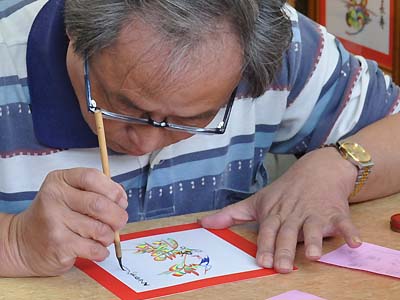
Coming from a design background, I have come to see text as an art form that is often manipulated as content or as part of a layout and for me, that is usually how I intermingle text with technology. Text is no longer a static form but it can also be animated. Looking back at the origins of text in its more static form, some examples of text as an artistic, symbolic form is its use in hieroglyphs and asian characters. Technology works to, in some form, mechanize the text through writing tools, printers and other text-making tools.
One mingling of text and technology that came to mind is the use of calligraphic tools not just for communication but as an art form. In Asia, the calligraphic brush was more widely used in the past to paint characters in languages. When painted, the symbols have flowing strokes and lines, with some strokes more emphasized than others. Today, those same characters in print have been “mechanized” and converted into harsh lines and strokes that are even throughout. The same can be said for handwriting.
What are the implications of text and technology today: How much have computers created a kind of convenience in the way we communicate and will handwritten texts still exist in the future? In the last 10 years alone, I think technology has done a great deal in changing the way we look at and learn how to use text using computers, cell phones and other, more advanced non-traditional devices.
Marjorie
September 18, 2009 2 Comments
Text : A poem by Rumi (1207-1273)
“That calligrapher wrote three different texts
The first text could be read by him and others
The second text could only be read by him, not by others
The third text could neither be read by him, nor by others
I am the third text”
September 17, 2009 No Comments
/ technology
Initial thoughts on technology… it’s an ‘ology’ – a science – but the word is used more as a catch-all category for the artefacts and techniques of human practicality . I’ve come to think of it more as a force, sometimes even a wilful or wayward one – as when you are staring up the left nostril of an important deadline and your computer crashes. (Never let an electronic or mechanical device know when you’re in a hurry. Whistle a tune. Look nonchalant.)
One of the great drawbacks of our current relationship to technology (either as a science or as a category of objects) – which is also a reflection of various aspects of our social structure, economy, etc. – is the extent to which objects and systems are designed (and supported) by people who don’t actually use them. I think this contributes greatly to our increasing surrender to semi-functional or dysfunctional systems, technical or social, on the premise that “that’s the way it is (or has to be)”. The “small cog in a huge machine” metaphor is increasingly applied to all areas of our lives, and the implication is not only that as individuals we are incomplete, uniform and replaceable, but that we cannot comprehend the scope and purpose of that of which we are a part. Bureaucracy is one of the results. And don’t let me get started on bureaucracy.
About technology, the OED says its earlier meaning (from the early 17th C) was “A discourse or treatise on an art or arts; the scientific study of the practical or industrial arts”, and from just a little later, “the terminology of a particular art or subject; technical nomenclature”. By the mid 19th C it was used to refer to “practical arts collectively”. By the latter half of the 20th C it appears again in the context of study or discussion; “technology assessment, the assessment of the effects on society of new technology”. (An interesting aside… technology has a homophone, tecnology – the scientific study of children. Apparently the spellchecker here hasn’t heard of it.)
Grandma’s 1927 Funk & Wagnall’s has a very short entry on the word – “The science that treats of the industrial or useful arts, such as metallurgy, brewing, weaving, building, etc. . . . The nomenclature or terminology of an art or science.” I like their notion of useful. Note that texere is to practice an art of interest to technology. (Lest you think F&W were Luddites, they also provide a highly detailed 1/3 page graphic of the Hoe Double Octuple Newspaper Web Perfecting printing press, with the rest of the page devoted to an explanation of printing technology and a list of related terms. Text again!)
September 17, 2009 No Comments
text /
Initial thoughts on text… when I’m thinking about a word I usually start with it as a ‘centre’ and work my way out, or around, imagining it as the centre of a web of other words – getting a sense of its full meaning and implications and variety through context (conTEXT).
text –> context –> subtext -> pretext…
So text starts as the written word, with implications of authority and permanence… then grows to define not only that with which it deals directly, but also that around it… and then to add nuance, shading, detail – and even doubt. (Now I’m thinking of Allan Fotheringham’s oft-used saying, “fuzzify the mudification”.)
And what does the dictionary say?
Text: from texere (Latin: to weave)… but as usage has developed, with much tendency to invoke authority and the establishment of the definitive. The emphasis is heavily on biblical scripture as defining text – or at least giving it its weight relative to lesser patches of common writing, wherever they may spring up. Purity creeps in there, too.
(In addition to the OED online I am also consulting my favourite dictionary: my grandmother’s 1927 edition of Funk and Wagnall’s New Standard Dictionary of the English Language, which is only very slightly smaller than the table it sits on and smells like the stacks in an old library. The two are essentially in agreement, but Grandma’s dictionary is more exciting – sometimes I find things she tucked between the pages. Rumour has it she hid money in there, too, but this may have been purely a ploy to promote literacy among her clan.)
Question to consider – what does textile have to do with text? Well, there’s the obvious root in texere… which makes each a form – or result – of weaving. A textile is “such as may be woven”. Which, if text derives from the verb to weave, means that words are textile – aren’t they?
September 17, 2009 1 Comment
Text we R, text i AM
Text, to me, is what we are, what I am. I love words and everything they make us and give us. I love reading. I love seeing words. In this information age, text defines us and gives us life. Text has allowed us to progress and move forward, but it has also isolated us from one another. We no longer need to seek the company of others in person. We can enclose ourselves in the safety of our homes and take on any persona our imagination allows. To me, text is me. It is the first time my daughter spells her name with the inverted C.
I chose the above concrete poem to represent what text is to me because it conveys what text is. It does an excellent job of illustrating the depth and breadth of text in modern languages.
September 16, 2009 No Comments
Text and Technology
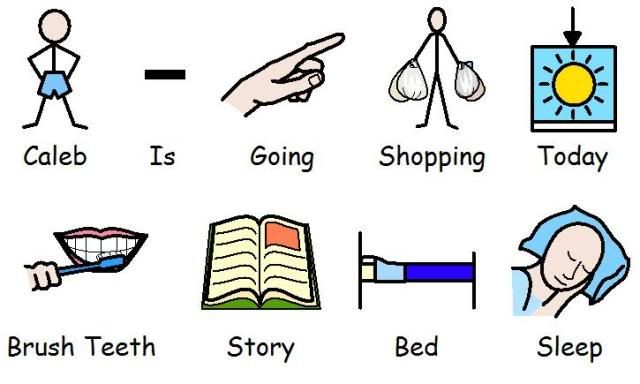
What is text? Is its classification still the same as it was when I was in school? Or my parents?
Do we allow for the shortened, grammatically incorrect form of language to be applied to this same category? The kind that is seen in countless text messages or quickly written emails?
Text comes in many forms, including the use of braille for those who have vision difficulties.
When I think of text and technology, I think of my students who cannot write. Those who use software that conveys an image or multiple images into a logical sentence or story. Boardmaker software, as shown above, is one example of how one can express their thoughts, and feelings without using the conventional alphabet.
Though I must ask: Is it still text?
September 16, 2009 2 Comments
‘Texting’
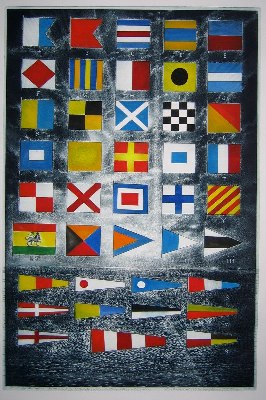
I’m not sure if this really satisfies the requirements. It’s not a definition but it is about text, sort of…
I was at an art gallery recently to look at the preview of a show that was about to open. The pieces were by Canadian artist David Blackwood. The gallery was pretty well empty that day except for the artist who was there to see how the show looked. We ended up having a long conversation, part of which involved this painting of flags. You can’t see it in this image but the flags all have letters of the alphabet underneath them. He told me how these flags would have been the main form of communication on the sailing ships. The idea was that during a battle there would be so much smoke at deck level that they would use the flags so they could be seen above the smoke. Apparently every captain would have someone standing next to him who would take messages and then run the message to the flag person, who would then hoist up the message. He gave the image of the man on Nelson’s ship running up the message, ‘England…expects…that…every…man…’. etc. This started me thinking along two lines. The first was how they were using text but re-invented the look of the text. Instead of letters being represented by lines and squiggles, now it was done with pictures, and a series of pictures could spell a word that someone else could easily understand. Which I guess means that any group can invent their own text. Which brings up my second thought. It seems like it would be a long long process to send a message that spelled words out with flags, so I wondered if maybe there was a recognised form of shorthand, and maybe the changes that are being made with text today, now that it’s become a verb, ‘texting’, in fact go back a long way. It would delight me to think that the flag person on Nelson’s ship was putting up a message along the lines of, ‘CU L8TR’.
September 16, 2009 No Comments
Textual Systems

news obsession word flow experiment #1, originally uploaded by Samuel Huron.
September 16, 2009 No Comments
Face-off: OED and Wikipedia
I am not nearly as brave as Drew, although we used the same springboard. He posted a wonderful multimedia interpretation. I’m afraid I’d be too incoherent. Six classes, three meetings, and twelve hours later, I will be grateful if I can form thoughts and type them. But here it goes…
The OED and Wikipedia connection and comparison offered in Module 1 is interesting. In my position teaching college students research skills, I am often called into classroom to destroy the authority of Wikipedia. Instead, I highlight its wonders and woes as I would with any resource.
Consulting Wikipedia for text was enlightening. There are eight entries. The longest by far is for the recent text messaging. The eight entries have multiple sub-headings and present very detailed accounts of text messaging’s social impact and worldwide use. Other entries of note are for the Swedish band, Text, and text as it applies to computing, “ordinary, unformatted, sequential file.” I started to ruminate on the entry for text as it relates to computing, (and might add another post) but decided to stay on course for the course.
Text (literary theory) needs to be “wikified to meet Wikipedia’s quality standards.Please help by adding relevant internal links, or by improving the article’s layout”. The other entry similar to OED, referring to the Bible/scripture, has no link to further information.
I’m reminded of Ammon Shea, author of Reading the OED: One man, one year, 21 730 pages, who described the OED as “a catalog of the foibles of the human condition”. It’s a reflection of its time, an historical perspective. The OED attempts to align with current communication and incorporate new word styles once they graduate from fads (CBC has wonderful, short segments lamenting additions from Homer’s “Doh!” to cyberphobic) but cannot keep pace with the ferocity with which Wikipedia grows.
The OED’s James Murray relied on Dr. William Chester Minor for close to ten thousand submissions while Wikipedia relies on millions from the masses. Dr. Minor was a murderer, clinically insane, and committed to an asylum. (The Professor and the mad man: A tale of murder, mystery, and the making of the Oxford English Dictionary details their extraordinary relationship as well as the building of the OED.)
I don’t mean to be delivering book reports, but the above helped me situate the two terms we’ve been deliberating – text and technology. I return to Drew’s post where he highlighted their interconnectedness. I do not argue against his thoughtful conclusions, but offer a twist. The emergence of technology forced a growth or manipulation of the understanding of text. As technology took hold, the other had to adapt or was adapted. I appreciated the images of weaving in the reading and on this blog, but am wondering if, in this case, there’s more of a push-pull; if technology isn’t subsuming text? And if so, what does this forecast?
I must truly be tired… as Derrida springs to mind. The relationship between the signifier and the signified shifts. There is nothing concrete and the signified varies in context – culture, time, etc. As I’ve just dumb-downed Derrida, I should stop. Actually, I should most likely wait until text‘s entry is wikified or be proactive and perform the ‘wikifying’ to create my own wikiality. (I’ve been trying to link to Stephen Colbert’s clip for half an hour, but am left hanging each time and now the icons are greyed out.)
September 16, 2009 No Comments
